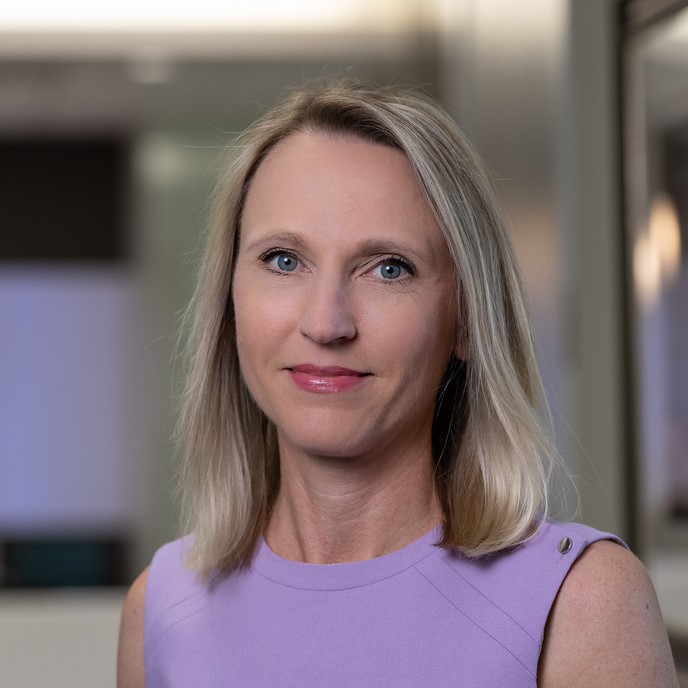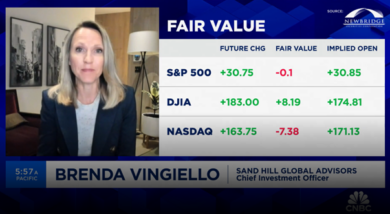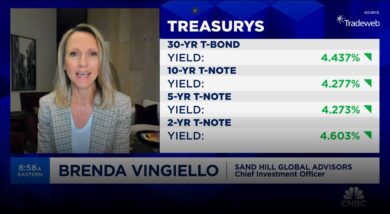Sand Hill's Chief Investment Officer, Brenda Vingiello, CFA, joins Jenny Harrington on “Halftime Report” to go over their most recent portfolio moves. Brenda's commentary begins

Is This What “Normal” Feels Like?
When the year began, it seemed like the economic landscape was great and only getting better. Congress had just passed a sweeping tax reform package, leading economic indicators suggested acceleration in economic growth, corporate earnings growth was being revised higher, and even tensions in North Korea appeared to be softening. The stock market reacted favorably to all of this, and January marked one of the best monthly starts to a year in history. However, the celebration quickly stopped when volatility meaningfully picked up in early February. Following the strong returns and historically low volatility of 2017, this felt particularly jarring.
As volatility persists, some speculate that the best days of this economic cycle are now behind us. Obviously, it is impossible to know exactly what the next few years might bring, but we believe that one thing is certain – that after many years of highly accommodative conditions for the markets, we can expect more normal circumstances going forward. So, what is normal anyway? In our view, this means that market volatility, interest rates, inflation, and corporate earnings growth expectations return to levels that are closer to historical averages.
When ruminating about market volatility, it is important to recognize just how calm and abnormal last year was. Volatility was so low that the S&P 500 had only eight days when it experienced a one-day move of one percent or more. This compares to an average year when this would have occurred roughly fifty times. This year, volatility is already tracking well above average as financial markets focus anew on many potential negative developments. More recently, this includes a possible trade war with China. And yet, strong first quarter corporate earnings should help ease concerns and shift general market sentiment back to strong fundamentals. Nevertheless, volatility will likely remain indefinitely high, especially as this economic cycle ages further.
In the middle to late stages of most economic cycles, interest rates are typically much higher than they are today. Indeed, interest rates have been so low for so long that it is hard to imagine a time when short-term interest rates were at 5%. However, over the last sixty years, this has actually been the average level, which is somewhat unsettling to consider. While we aren’t expecting a significant move anytime soon, longer-term interest rates should begin to rise as the Federal Reserve continues to raise short-term rates with the growth of the global economy. And as monetary policy tightens, history suggests that financial market volatility will rise as investors question just how high interest rates can go before they contribute to an economic slowdown. Given that interest rates remain so low relative to historical levels and that inflation continues to be muted, this doesn’t appear to be a near-term risk; but this could certainly change, particularly if inflation shows signs of moving at a meaningfully faster pace.
Recent measures of inflation suggest that a very slight pick-up is occurring, especially with wage growth. This doesn’t come as a surprise given the strength of the job market and, in fact, it is a healthy development that we have been waiting to see for quite some time. Even so, it represents a change that may weigh on the financial markets for a while as participants digest the potential impact on economic growth as well as the ultimate level of interest rates over time.
Meanwhile, corporate America is poised to have banner earnings growth this year due to a strong combination of positive global economic growth, lower corporate domestic tax rates, repatriation of overseas cash, and recently enacted incentives to spend on capital expenditures. Some of this positive impact may spill over into 2019, particularly if projects planned now begin to ramp up next year; however, next year will likely be relatively more challenging and characterized by a generally slower growth environment that may eventually cause concern to equity markets. At the current moment, reasonable valuations and strong earnings growth should support a positive return environment for stocks, but this favorable landscape could change as the year wears on and investors focus more of their attention on 2019 and beyond.
Ironically, in many ways, this entire economic cycle can be categorized as being abnormal. This is primarily a function of the severity of the financial crisis we faced in 2008 and the extreme measures that the Federal Reserve took to stabilize, and ultimately grow, the economy. Almost a decade later, it appears that we are finally getting back to “normal” and this will require some adjustment as it creates new levels of uncertainty. Still, it is important to remember that normal isn’t necessarily bad – in fact, it’s a good thing! Some things, such as the highly polarized present political environment, aren’t likely to normalize anytime soon, though they may not end up having a lasting impact on the global economy, either. Bottom line – the financial environment remains quite fluid. Given what we know today, we plan to navigate this environment on your behalf by opportunistically reducing overall exposure to growth assets throughout the year, and in turn look to other types of investments that can provide uncorrelated outcomes, as well as those that can help reduce volatility and take advantage of increasing interest rates.
Articles and Commentary
Information provided in written articles are for informational purposes only and should not be considered investment advice. There is a risk of loss from investments in securities, including the risk of loss of principal. The information contained herein reflects Sand Hill Global Advisors' (“SHGA”) views as of the date of publication. Such views are subject to change at any time without notice due to changes in market or economic conditions and may not necessarily come to pass. SHGA does not provide tax or legal advice. To the extent that any material herein concerns tax or legal matters, such information is not intended to be solely relied upon nor used for the purpose of making tax and/or legal decisions without first seeking independent advice from a tax and/or legal professional. SHGA has obtained the information provided herein from various third party sources believed to be reliable but such information is not guaranteed. Certain links in this site connect to other websites maintained by third parties over whom SHGA has no control. SHGA makes no representations as to the accuracy or any other aspect of information contained in other Web Sites. Any forward looking statements or forecasts are based on assumptions and actual results are expected to vary from any such statements or forecasts. No reliance should be placed on any such statements or forecasts when making any investment decision. SHGA is not responsible for the consequences of any decisions or actions taken as a result of information provided in this presentation and does not warrant or guarantee the accuracy or completeness of this information. No part of this material may be (i) copied, photocopied, or duplicated in any form, by any means, or (ii) redistributed without the prior written consent of SHGA.
Video Presentations
All video presentations discuss certain investment products and/or securities and are being provided for informational purposes only, and should not be considered, and is not, investment, financial planning, tax or legal advice; nor is it a recommendation to buy or sell any securities. Investing in securities involves varying degrees of risk, and there can be no assurance that any specific investment will be profitable or suitable for a particular client’s financial situation or risk tolerance. Past performance is not a guarantee of future returns. Individual performance results will vary. The opinions expressed in the video reflect Sand Hill Global Advisor’s (“SHGA”) or Brenda Vingiello’s (as applicable) views as of the date of the video. Such views are subject to change at any point without notice. Any comments, opinions, or recommendations made by any host or other guest not affiliated with SHGA in this video do not necessarily reflect the views of SHGA, and non-SHGA persons appearing in this video do not fall under the supervisory purview of SHGA. You should not treat any opinion expressed by SHGA or Ms. Vingiello as a specific inducement to make a particular investment or follow a particular strategy, but only as an expression of general opinion. Nothing presented herein is or is intended to constitute investment advice, and no investment decision should be made based solely on any information provided on this video. There is a risk of loss from an investment in securities, including the risk of loss of principal. Neither SHGA nor Ms. Vingiello guarantees any specific outcome or profit. Any forward-looking statements or forecasts contained in the video are based on assumptions and actual results may vary from any such statements or forecasts. SHGA or one of its employees may have a position in the securities discussed and may purchase or sell such securities from time to time. Some of the information in this video has been obtained from third party sources. While SHGA believes such third-party information is reliable, SHGA does not guarantee its accuracy, timeliness or completeness. SHGA encourages you to consult with a professional financial advisor prior to making any investment decision.
Other Posts By This Author
- – CNBC Halftime: Portfolio Moves | March 14, 2024
- – CNBC Squawk Box: Market Trends | March 6, 2024
- – CNBC Squawk Box: CPI Report | February 13, 2024
- – Getting Back to Normal
Related Posts







